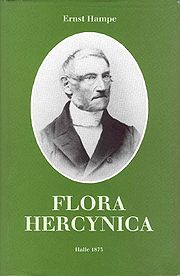
Georg Ernst Ludwig Hampe
Encyclopedia

Pharmacist
Pharmacists are allied health professionals who practice in pharmacy, the field of health sciences focusing on safe and effective medication use...
, botanist and bryologist who was a native of Fürstenberg
Fürstenberg, Lower Saxony
Fürstenberg is a municipality in the district of Holzminden, in Lower Saxony, Germany and lies on the River Weser in the Weser Uplands near Höxter and Holzminden. The Fürstenberg China Factory, founded in 1747, is the second-oldest porcelain manufacturer in Germany....
.
In 1810 he became an apprentice pharmacist
Pharmacist
Pharmacists are allied health professionals who practice in pharmacy, the field of health sciences focusing on safe and effective medication use...
to his uncle in Brakel
Brakel, Germany
Brakel is a town in the district of Höxter in North Rhine-Westphalia, Germany.- Location :Brakel lies at the midpoint of the district of Höxter between the Eggegebirge and the Weser in the Oberwälder Land nature area in the old Saxon region of Nethegau....
, and over the next fifteen years worked in a number of pharmacies at several locations, including in Halle an der Saale (where he became acquainted with botanist Kurt Sprengel 1766-1833), at the university pharmacy
Pharmacy
Pharmacy is the health profession that links the health sciences with the chemical sciences and it is charged with ensuring the safe and effective use of pharmaceutical drugs...
in Göttingen, in the town of Allendorf
Allendorf
Allendorf may refer to the following places:*in Germany:**Allendorf, Gießen, a town in the Gießen district, Hesse**Allendorf, Waldeck-Frankenberg, a municipality in the Waldeck-Frankenberg district, Hesse...
, and later in the city of Braunschweig
Braunschweig
Braunschweig , is a city of 247,400 people, located in the federal-state of Lower Saxony, Germany. It is located north of the Harz mountains at the farthest navigable point of the Oker river, which connects to the North Sea via the rivers Aller and Weser....
. In 1825 he became head of a local pharmacy in Blankenburg am Harz
Blankenburg am Harz
Blankenburg is a town and health resort in the district of Harz, in Saxony-Anhalt, Germany, at the north foot of the Harz Mountains, southwest of Halberstadt....
, where he remained its director until 1864.
During his time at Blankenburg, Hampe collected and studied flora native to the Harz Mountains. He was particularly interested in mosses, and through his association with bryologist Karl Müller
Karl Müller (bryologist)
Johann Karl August Müller was a German bryologist who was a native of Allstedt.Until 1843 he worked as a pharmacist in several locations in Germany, and from 1843 to 1846 studied botany at the University of Halle. In 1843 he was an assistant editor of Botanische Zeitung, and in 1852 was co-founder...
(1818-1899), he became exposed to non-European species from the Americas, Madagascar, New Zealand, Australia, et al. In his collaborative research with Müller, he described numerous new bryological species.
Later in life, Hampe received an honorary professorship from the University of Göttingen. In 1876 he sold his pharmacy in Blankenburg, and moved to Helmstedt
Helmstedt
Helmstedt is a city located at the eastern edge of the German state of Lower Saxony. It is the capital of the District of Helmstedt. Helmstedt has 26,000 inhabitants . In former times the city was also called Helmstädt....
, where he went to live with his son. After Hampe's death, his large herbarium
Herbarium
In botany, a herbarium – sometimes known by the Anglicized term herbar – is a collection of preserved plant specimens. These specimens may be whole plants or plant parts: these will usually be in a dried form, mounted on a sheet, but depending upon the material may also be kept in...
was acquired by the British Museum of Natural History. The plant genus Hampea
Hampea
Hampea is a flowering plant genus in the family Malvaceae. Species include:* Hampea appendiculata* Hampea breedlovei* Hampea dukei* Hampea micrantha* Hampea montebellensis* Hampea reynae – Majagua...
from the family Malvaceae
Malvaceae
Malvaceae, or the mallow family, is a family of flowering plants containing over 200 genera with close to 2,300 species. Judd & al. Well known members of this family include okra, jute and cacao...
was named in his honor by Dietrich von Schlechtendal
Diederich Franz Leonhard von Schlechtendal
Diederich von Schlechtendal was a German botanist born in Xanten. He was Professor of Botany and Director of the Botanical Gardens at the Martin Luther University of Halle-Wittenberg from 1833 until his death in 1866, and Editor of the botanical journal Linnaea.His most important work was in...
(1794-1866).
Selected publications
- Prodromus flora Hercynicae (Halle 1836, Nordhausen 1842)
- Vegetabilia cellularia in Germania septentrionale praesertim in Hercynia et in agro Gottingensi (1834 and 1836), with Friedrich Gottlieb BartlingFriedrich Gottlieb BartlingFriedrich Gottlieb Bartling was a German botanist who was a native of Hanover.He studied natural sciences at the University of Göttingen, and in 1818 took a botanical journey through Hungary and Croatia. In 1822 he became a lecturer at Göttingen, where he later became a professor, and in 1837 was...
(1798–1875). - Linnaea (1844)
- Icones muscorum novorum vel minus cognitorum (Bonn 1844)
- Flora Hercynica oder Aufzählung der im Harzgebiete wildwachsenden Gefässpflanzen (1873)
- Flora Hercynica (Halle 1875)

